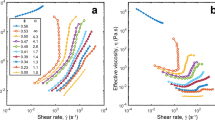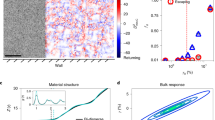Abstract
Dense suspensions of hard particles in a liquid can exhibit strikingly counter-intuitive behaviour, such as discontinuous shear thickening (DST)1,2,3,4,5,6,7 and reversible shear jamming (SJ) into a state where flow is arrested and the suspension is solid-like8,9,10,11,12. A stress-activated crossover from hydrodynamic interactions to frictional particle contacts is key for these behaviours2,3,4,6,7,9,13. However, in experiments, many suspensions show only DST, not SJ. Here we show that particle surface chemistry plays a central role in creating conditions that make SJ readily observable. We find the system’s ability to form interparticle hydrogen bonds when sheared into contact elicits SJ. We demonstrate this with charge-stabilized polymer microspheres and non-spherical cornstarch particles, controlling hydrogen bond formation with solvents. The propensity for SJ is quantified by tensile tests12 and linked to an enhanced friction by atomic force microscopy. Our results extend the fundamental understanding of the SJ mechanism and open avenues for designing strongly non-Newtonian fluids.
This is a preview of subscription content, access via your institution
Access options
Access Nature and 54 other Nature Portfolio journals
Get Nature+, our best-value online-access subscription
$29.99 / 30 days
cancel any time
Subscribe to this journal
Receive 12 print issues and online access
$259.00 per year
only $21.58 per issue
Buy this article
- Purchase on Springer Link
- Instant access to full article PDF
Prices may be subject to local taxes which are calculated during checkout





Similar content being viewed by others
Data availability
The datasets generated during and/or analysed during the current study are available from the corresponding author on reasonable request.
References
Barnes, H. A. Shear-thickening (‘dilatancy’) in suspensions of nonaggregating solid particles dispersed in Newtonian liquids. J. Rheol. 33, 329–367 (1989).
Seto, R., Mari, R., Morris, J. F. & Denn, M. M. Discontinuous shear thickening of frictional hard-sphere suspensions. Phys. Rev. Lett. 111, 218301 (2013).
Fernandez, N. et al. Microscopic mechanism for shear thickening of non-Brownian suspensions. Phys. Rev. Lett. 111, 108301 (2013).
Wyart, M. & Cates, M. Discontinuous shear thickening without inertia in dense non-Brownian suspensions. Phys. Rev. Lett. 112, 098302 (2014).
Brown, E. & Jaeger, H. M. Shear thickening in concentrated suspensions: phenomenology, mechanisms and relations to jamming. Rep. Prog. Phys. 77, 046602 (2014).
Mari, R., Seto, R., Morris, J. F. & Denn, M. M. Discontinuous shear thickening in Brownian suspensions by dynamic simulation. Proc. Natl Acad. Sci. USA 112, 15326–15330 (2015).
Royer, J. R., Blair, D. L. & Hudson, S. D. Rheological signature of frictional interactions in shear thickening suspensions. Phys. Rev. Lett. 116, 188301 (2016).
Waitukaitis, S. R. & Jaeger, H. M. Impact-activated solidification of dense suspensions via dynamic jamming fronts. Nature 487, 205–209 (2012).
Ness, C. & Sun, J. Shear thickening regimes of dense non-Brownian suspensions. Soft Matter 12, 914–924 (2015).
Peters, I. R., Majumdar, S. & Jaeger, H. M. Direct observation of dynamic shear jamming in dense suspensions. Nature 532, 214–217 (2016).
Han, E., Peters, I. & Jaeger, H. High-speed ultrasound imaging in dense suspensions reveals impact-activated solidification due to dynamic shear jamming. Nat. Commun. 7, 12243 (2016).
Majumdar, S., Peters, I. R., Han, E. & Jaeger, H. M. Dynamic shear jamming in dense granular suspensions under extension. Phys. Rev. E 95, 012603 (2017).
Guy, B. M., Hermes, M. & Poon, W. C. Towards a unified description of the rheology of hard-particle suspensions. Phys. Rev. Lett. 115, 088304 (2015).
Bi, D., Zhang, J., Chakraborty, B. & Behringer, R. Jamming by shear. Nature 480, 355–358 (2011).
Brown, E. et al. Generality of shear thickening in dense suspensions. Nat. Mater. 9, 220–224 (2010).
Appel, J., Akerboom, S., Fokkink, R. & Sprakel, J. Facile one-step synthesis of monodisperse micron-sized latex particles with highly carboxylated surfaces. Macromol. Rapid Commun. 34, 1284–1288 (2013).
Oyarte Galvez, L., de Beer, S., van der Meer, D. & Pons, A. Dramatic effect of fluid chemistry on cornstarch suspensions: linking particle interactions to macroscopic rheology. Phys. Rev. E 95, 030602 (2017).
Fall, A. et al. Macroscopic discontinuous shear thickening versus local shear jamming in cornstarch. Phys. Rev. Lett. 114, 098301 (2015).
Jerome, J. J., Vandenberghe, N. & Forterre, Y. Unifying impacts in granular matter from quicksand to cornstarch. Phys. Rev. Lett. 117, 098003 (2016).
Smith, M. I., Besseling, R., Cates, M. E. & Bertola, V. Dilatancy in the flow and fracture of stretched colloidal suspensions. Nat. Commun. 1, 114 (2010).
Bischoff White, E. E., Chellamuthu, M. & Rothstein, J. P. Extensional rheology of a shear-thickening cornstarch and water suspension. Rheologica Acta 49, 119–129 (2009).
Singh, A., Mari, R., Denn, M. M. & Morris, J. F. A constitutive model for simple shear of dense frictional suspensions. J. Rheology 62, 457–468 (2017).
Qin, J., Zhang, G., Ma, Z., Zhou, L. & Shi, X. Effects of ionic structures on shear thickening fluids composed of ionic liquids and silica nanoparticles. RSC Advances 6, 81913–81923 (2016).
Warren, J. et al. Effect of temperature on the shear-thickening behavior of fumed silica suspensions. ACS Appl. Mater. Interfaces 7, 18650–18661 (2015).
Comtet, J. et al. Pairwise frictional profile between particles determines discontinuous shear thickening transition in non-colloidal suspensions. Nat. Commun. 8, 15633 (2017).
Boyer, F., Sandoval-Nava, E., Snoeijer, J. H., Dijksman, J. F. & Lohse, D. Drop impact of shear thickening liquids. Phys. Rev. Fluids 1, 013901 (2016).
Maharjan, R. & Brown, E. Giant deviation of a relaxation time from generalized Newtonian theory in discontinuous shear thickening suspensions. Phys. Rev. Fluids 2, 123301 (2017).
Han, E., Van Ha, N. & Jaeger, H. M. Measuring the porosity and compressibility of liquid-suspended porous particles using ultrasound. Soft Matter 13, 3506–3513 (2017).
Acknowledgements
We thank S. Majumdar, I. Peters and M. Lueckeheide for insightful discussions. This work was supported by the University of Chicago Women’s Board, and the US Army Research Office through grant W911NF-16-1-0078. Additional support was provided by the Chicago MRSEC, funded by the NSF through grant DMR-1420709. E.H. acknowledges support from the Center for Hierarchical Materials Design (CHiMaD).
Author information
Authors and Affiliations
Contributions
N.M.J. and H.M.J. conceived of the project and designed the experiments. N.M.J. synthesized and characterized particles, performed the tensile tests and rheological experiments, and analysed data. E.H. performed the ultrasound experiments, particle image velocimetry (PIV) analysis, fast tensile tests, and analysed rheology data to obtain the state diagram. R.L. performed AFM measurements and their analysis. J.J. assisted with AFM measurements and their analysis. N.M.J. and H.M.J wrote the manuscript.
Corresponding author
Ethics declarations
Competing interests
The authors declare no competing interests.
Additional information
Publisher’s note: Springer Nature remains neutral with regard to jurisdictional claims in published maps and institutional affiliations.
Supplementary information
Supplementary Information
Supplementary Video Legend 1, Supplementary Figures 1–6
Supplementary Video 1
Tensile test videos. Videos of the pull test experiment on each system described in Figure 2
Rights and permissions
About this article
Cite this article
James, N.M., Han, E., de la Cruz, R.A.L. et al. Interparticle hydrogen bonding can elicit shear jamming in dense suspensions. Nature Mater 17, 965–970 (2018). https://doi.org/10.1038/s41563-018-0175-5
Received:
Accepted:
Published:
Issue Date:
DOI: https://doi.org/10.1038/s41563-018-0175-5
This article is cited by
-
Role of plasticity in the universal scaling of shear-thickening dense suspensions
Rheologica Acta (2024)
-
Nanostructured lubricant additives for titanium alloy: Lubrication by the solid-liquid interface with Coulomb repulsion
Friction (2024)
-
A soil-inspired dynamically responsive chemical system for microbial modulation
Nature Chemistry (2023)
-
Development of cornstarch-based shear thickening fluid and characterization of the effects of the addition of halloysite nanotubes-silica hybrid reinforcements
Journal of Polymer Research (2023)
-
Effects of nano-fumed silica and carbonyl iron powder of different particle sizes on the rheological properties of shear thickening fluids
Colloid and Polymer Science (2023)



